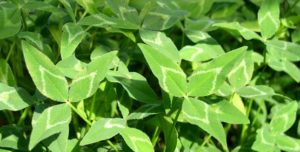Source: foragefax.tamu.edu | Aug. 23, 2019
The options for fall-planted wildlife mixtures are many but often the random mixtures offered for sale by national retailers are not the best-adapted plants for Texas. Warm season forage legumes, cool season forage legumes and forage oats are all great choices to include in forage mixtures for white-tailed deer in Texas. One problem with planting mixtures of these three forages is determining the correct planting rate for each forage species so that competition is minimized and each species can be productive.
Planting rate experiments with cowpeas, oats and clover were conducted at multiple East Texas locations and in multiple years. In the most recent experiment, six different mixtures of ‘Iron and Clay’ cowpeas, ‘HeavyGrazer’ oats and ‘Apache’ arrowleaf clover were planted at Overton on Aug. 27. All mixtures included 10 lbs/acre Apache arrowleaf. The planting rates of cowpea ranged from 20 to 60 lbs/acre and the planting rates of oats ranged from 10 to 40 lbs/acre. All mixtures were broadcast on freshly disked seedbeds and rolled to lightly cover the seed and insure good seed to soil contact. Fertilizer and lime were applied prior to planting according to soil test. Each plot was sampled for forage yield at 30 days post planting and at 30 day intervals until June.

In the early fall harvests (late Sept. and late Oct.) the high cowpea planting rates produced more cowpea forage but restricted oat production, regardless of oat planting rate. The cowpeas were killed by frost just prior to the late November harvest. In early Jan. the arrowleaf clover forage yield was best at the low cowpea planting rates, reflecting the effect of previous competition from the thick stands of cowpea. Oat forage yield in the early January harvest did not show the same response to cowpea planting rate. The mixture of 40 lbs/acre cowpea + 40 lbs/acre oats + 10 lbs/acre arrowleaf clover provided the best distribution of forage production from early fall to early summer.
Recommendations:
General
- Make plans to plant between last week of August and second week of September.
- Soil test area to be planted (your local county Extension Agent can provide information).
- Apply fertilizer and lime as recommended by soil test.
- Disk area to be planted 2 weeks prior to planting.
- Clover seed will be pre-inoculated. Purchase inoculum for cowpeas and inoculated on day of planting.
- Disk again on day of planting. Roll or drag after broadcasting seed.
East Texas Piney Woods and Post Oak Savannah Ecoregions
Recommended varieties and seeding rates. Choose one from each species.
Cowpea
- Iron and Clay, 40 lbs/acre
- Ace, 30 lbs/acre
Oats
- HeavyGrazer, 40 lbs/acre
Clover
- Apache arrowleaf, 10 lbs/acre
- Blackhawk arrowleaf, 10 lbs/acre
Blackland Prairie Ecoregion
Recommended varieties and seeding rates. Choose one from each species.
Cowpea
- Iron and Clay, 40 lbs/acre
- Ace, 30 lbs/acre
Oats
- HeavyGrazer, 40 lbs/acre
Clover
- Silver River sweetclover, 10 lbs/acre
R. Smith, Texas A&M AgriLife Research, Overton
B. Higginbotham, Texas A&M AgriLife Extension Service, Retired, Overton
Vanessa Corriher-Olson, Forage Extension Specialist, Soil & Crop Sciences, Overton
